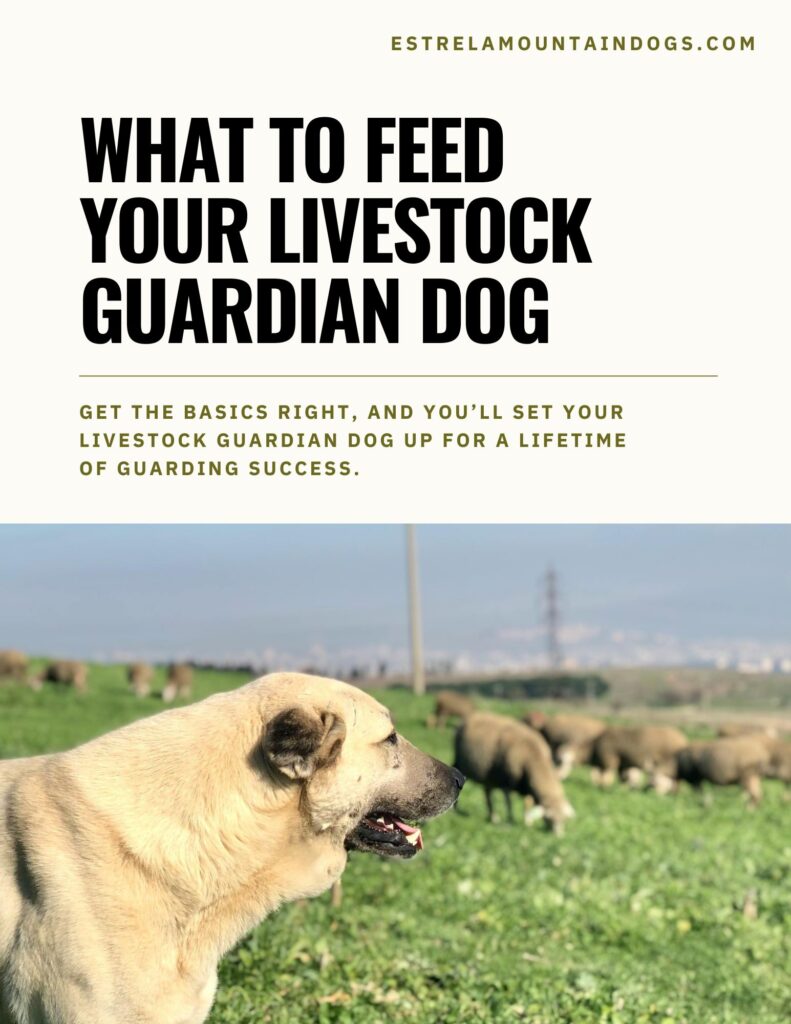
What to Feed Your Livestock Guardian Dog
Another common question I get from new puppy families is: “What should I feed my livestock guardian dog?” What do you feed your Estrela Mountain Dogs?
Feeding a livestock guardian dog (LGD) isn’t quite the same as feeding your average family dog. These dogs are big, slow to mature, and bred to work long hours in the field. The right nutrition makes the difference between a dog that stays sound into old age and one that struggles with joint problems by three.
Let’s go through the info together:
- What to feed a livestock guardian dog at every stage
- How to feed a livestock guardian dog puppy for steady growth
- Why calcium and phosphorus matter more than you think
- Five dog food options you can use as a starting point
Balanced Diet Comes First
Every dog needs balance. I can’t stress this enough. Yes, you can feed raw, but only if you’re working with a veterinary nutritionist who has experience formulating for large breeds. Raw done right is a science. Raw done wrong is just…chicken and rice, and that’s not going to be healthy long term.
For the first two years, your LGD’s diet shapes their future. That’s when their skeleton and joints are forming. Feed them right, and you’ll have a strong, sound guardian. Feed them wrong, and you’ll end up with preventable problems down the line.
Why Slow Growth for Livestock Guardian Dog Puppies is Key
Livestock guardian dogs are late bloomers.
- By 2 years old, their skeleton is mostly finished.
- Between 2–3 years, they’re still filling out with muscle.
That’s why high-protein, high-fat puppy foods marketed are a red flag for giant breed puppies. You don’t want fast growth. You want slow, steady, healthy growth.
When people ask me how to feed a livestock guardian dog puppy, I always say: feed for long-term joints, not short-term size.
Calcium and Phosphorus: The Growth Balancers
Calcium and phosphorus are the building blocks of bone and muscle. They need to stay close to a 1:1 ratio. For example:
- If the food has 1.2% calcium, phosphorus should be around 1.1–1.2%.
Too much of either, and you risk joint or skeletal issues. The tricky part? Dog food bags list minimum percentages, not maximums. That means the actual number could be higher.
👉 Tip: Always check the guaranteed analysis on the back of the bag. The front label (“grain-free!” “gluten-free!” “holistic!”) is just marketing.
What to Look for in Dog Food for Livestock Guardian Dogs
- AFCO-approved (Association of American Feed Control Officials)
- Labeled All Life Stages (this covers large-breed puppies)
- Moderate protein (around 24–26%)
- Moderate fat (around 14–18%)
- A good balance of carbs for energy
Here’s what I personally feed: a 26% protein, 16% fat, all life stages formula. It’s balanced, safe for large-breed puppies, and doesn’t push them to grow too fast.
Dog Food List: 5 Options for LGDs
Here are five foods that typically meet the needs of livestock guardian dogs. Always double-check the bag before you buy, since formulas change.
1. Inukshuk Professional Dog Food 26/16

- Designed for working and sporting dogs
- Balanced protein/fat for sustained energy without overgrowth
- Great choice for active LGDs in the field
👉 Inukshuk Professional 26/16
2. Muenster Ancient Grains 30/20
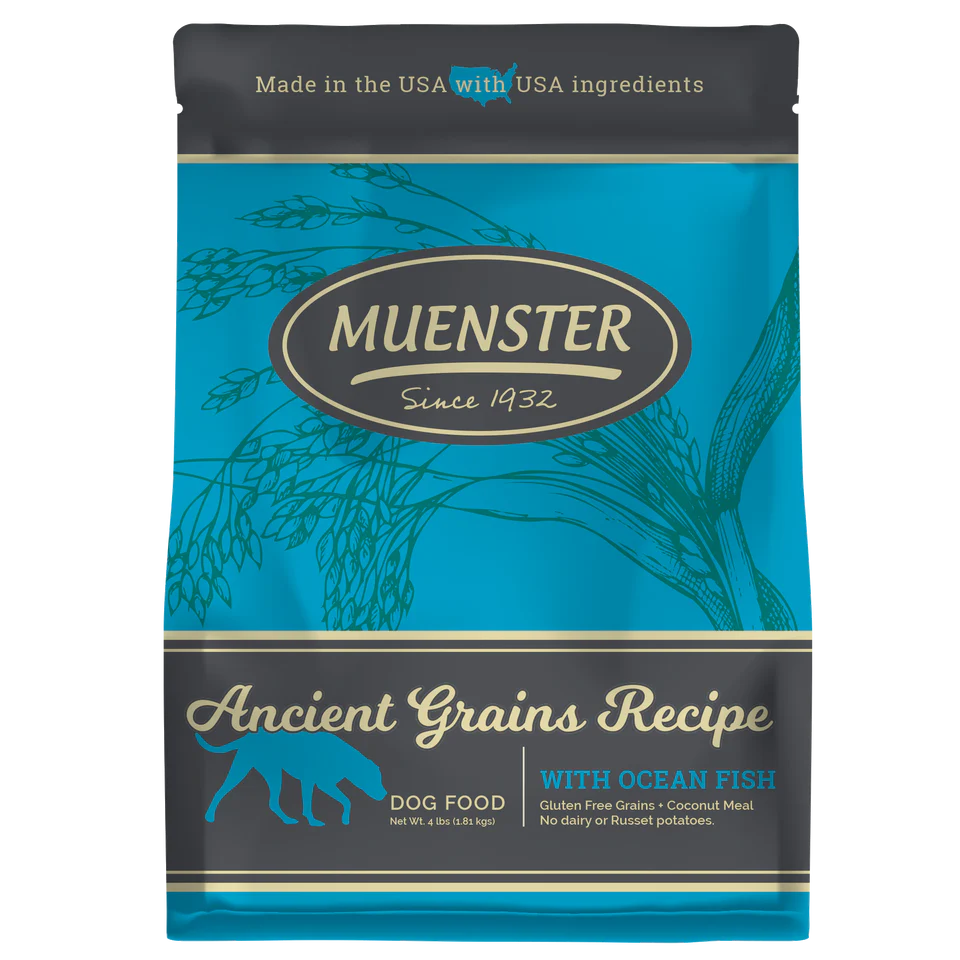
- Grain-inclusive formula with slow-release energy
- Texas-made, family-owned company with consistent formulas
- Works well for LGDs with higher activity levels
👉 Muenster Ancient Grains Dog Food
3. Purina Pro Plan Sensitive Skin & Stomach (Salmon & Rice Formula)
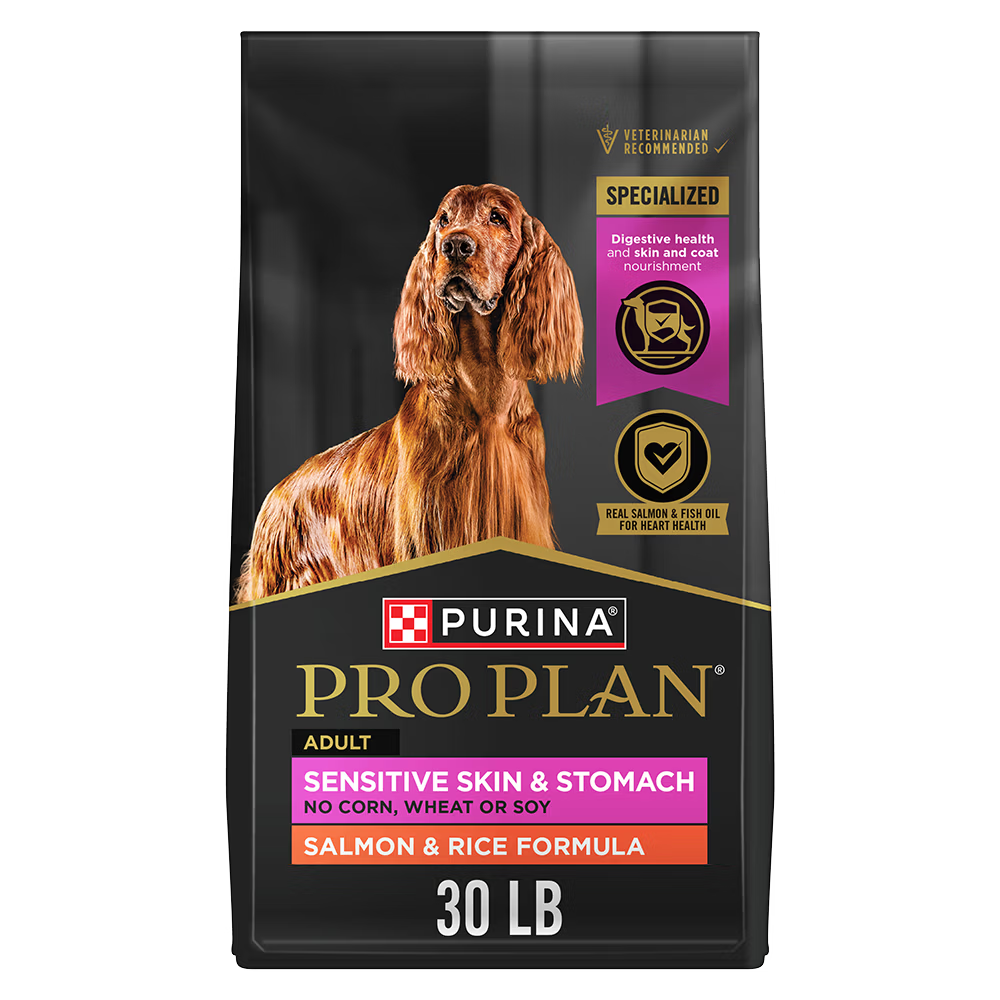
- Formulated for dogs with allergies or sensitive digestion
- Contains salmon as the main protein, plus rice and oatmeal for easy digestion
- Maintains balanced nutrition for LGDs without skipping grains
👉 Purina Pro Plan Sensitive Skin & Stomach
4. Victor Hi-Pro Plus (All Life Stages)
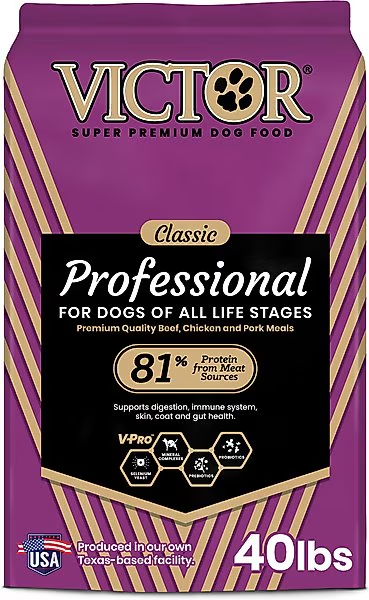
- A classic 30/20 formula safe for all life stages
- Grain-inclusive with consistent quality
- A solid option for LGDs in both training and light work
👉 Victor Hi-Pro Plus Dog Food
5. Diamond Naturals All Life Stages 26/16
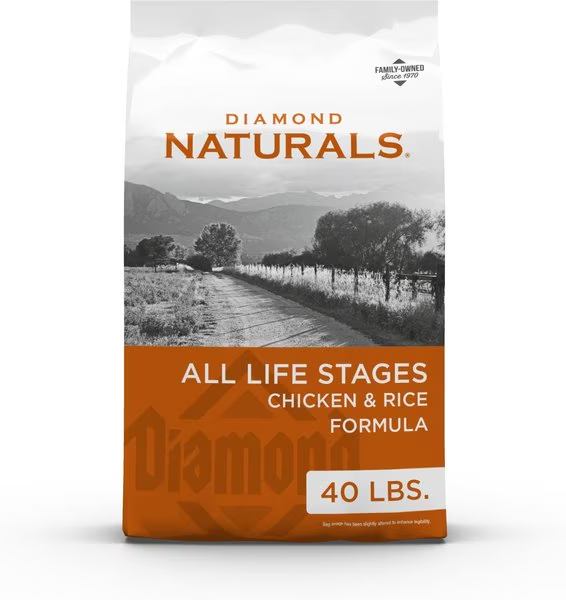
- Affordable, reliable, and widely available
- Balanced for both growth and maintenance
- A great everyday choice if you want steady, slow development in your LGD
👉 Diamond Naturals All Life Stages
Overfeeding a Livestock Guardian Dog: Why Bigger Isn’t Better
I see it all the time: someone proudly says, “My six-month-old puppy already weighs 90 pounds!” That’s not a brag. That’s a warning sign.
The largest puppy in a litter at 8 weeks is rarely the largest adult. Often, the “runt” catches up once they’re on their own. Feeding for size instead of balance usually backfires.
With livestock guardian dogs, feeding too much too soon can mean joint issues, hip problems, and an overweight adult who can’t do their job.
How to Transition to New Food
When you bring your puppy home, I’ll usually send you with some of the food they’ve been eating. If you want to switch:
- Start with 25% new food, 75% old food
- Move to 50/50 after a few days
- Then 75/25
- Fully transition after about 7–10 days
This gradual shift keeps their stomach settled. If you need to transition a livestock guardian dog to a different food, do it slowly and not all at once.
Why You Shouldn’t Feed Your Livestock Guardian Dog Boutique Foods
I know the bags with fancy names and pretty designs are tempting. Brands like to market words like grain-free, gluten-free, holistic, ancestral, human-grade, and it makes us feel like we’re giving our dogs something special. But here’s the problem: many of these “boutique” foods are designed to appeal to you, not to meet the actual nutritional needs of a large-breed working dog.
Boutique Foods vs. Proven Brands
| Big, Researched Brands (Purina, Royal Canin, Diamond, Victor) | Boutique Foods (grain-free, boutique, holistic labels) |
|---|---|
| Backed by feeding trials and decades of research | Rarely run feeding trials |
| Calcium/phosphorus ratios tested for large breeds | Ratios often inconsistent or untested |
| Balanced protein and fat for slow, steady growth | Often push higher protein/fat that encourage overgrowth |
| Use grains for slow-release energy | Marketed as grain-free, which can increase health risks |
| Widely available, affordable, consistent | Expensive, inconsistent, and marketed toward humans, not dogs |
👉 Bottom line: trust the science, not the marketing.
The Grain-Free and DCM Issue
There’s another serious reason to avoid boutique grain-free foods: DCM (Dilated Cardiomyopathy).
DCM is a heart condition that has been linked to grain-free diets, especially those heavy in peas, lentils, or potatoes. The FDA has investigated this connection for years, and while the research is ongoing, the risk is real.
Livestock guardian dogs (Estrela Mountain Dogs, Great Pyrenees, Anatolians, etc.) are already prone to cardiac issues. Feeding a grain-free boutique food increases that risk dramatically. For that reason, we do not feed grain-free diets to LGDs. These dogs need balanced, grain-inclusive nutrition to protect their hearts and keep them working strong for years to come.
Treats Without Throwing Off Balance
Most store-bought treats are too rich. If you love training with food, here’s what I recommend:
- Use their kibble as treats
- Hand-feed meals for bonding and training
- Scatter kibble in the grass for enrichment
Bowls aren’t even required — meals can double as training opportunities. Most of your puppies kibble should be used during short training sessions throughout the day.
Special Resource for Hard Keepers
Some LGDs, no matter how well they’re fed, struggle to hold weight. If your guardian is underweight or recovering from illness, you may need a higher-calorie recipe to give them an extra boost. One option is Satin Balls, a high-fat, nutrient-dense supplement recipe designed for dogs that need to put on pounds quickly.
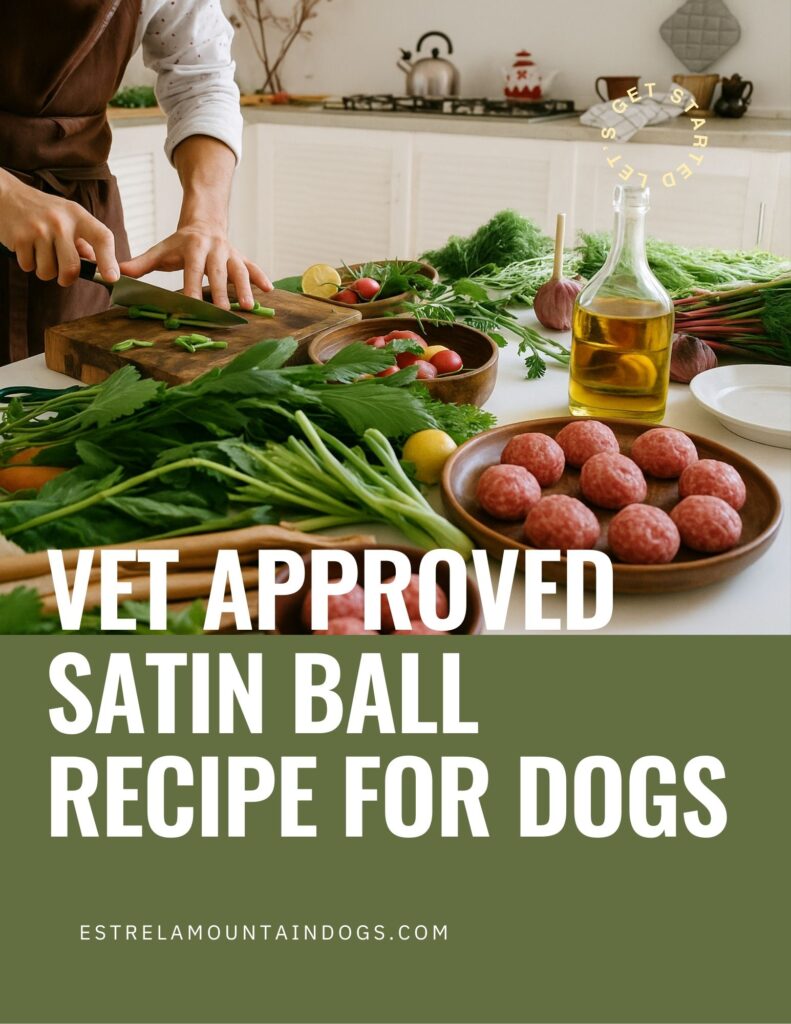
👉 Read my full Satin Balls recipe for LGDs that can’t gain weight
Final Thoughts
Here’s the short version of what to feed a livestock guardian dog:
- Balanced, AFCO-approved all life stages food
- Moderate protein and fat (around 26/16)
- Calcium-phosphorus close to 1:1
- Slow, steady growth — not rapid weight gain
And here’s how to feed a livestock guardian dog puppy:
- Feed for health, not size
- Transition slowly if switching foods
- Use kibble as treats instead of high-calorie extras
Feeding an LGD isn’t complicated once you know what to look for. Get the basics right, and you’ll set your dog up for a lifetime of guarding success.
Posts You Might Like
Looking for more support with your livestock guardian dog? Check out these questions and Info posts
Comments +